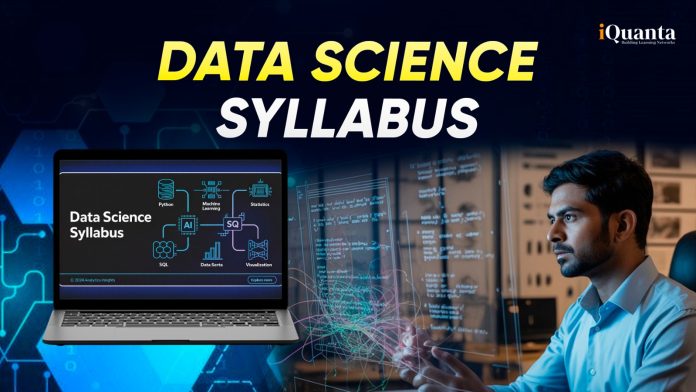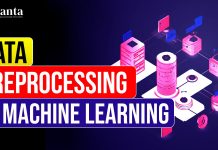In the data driven era today, the data science domain is one of the most in-demand and fastest growing fields. From tech giants to startups, every company relies on data science to extract valuable insights, improve decision-making and drive technological innovations. However, breaking into the data science domain can feel enthusiastic due to the large number of concepts, tools and technologies involved. That’s where a well-structured data science syllabus is important.
Whether you are a beginner, a college student, or a working professional planning a career switch, understanding the right data science syllabus helps you to learn step-by-step concepts starting from programming and statistics to machine learning and big data. In this blog, we will explore the complete data science syllabus for 2025, including the tools you will need. This guide is your first step towards the journey of becoming a Data Scientist, ML Engineer and many more awaiting.
What is Data Science?
Data is everywhere almost starting from your google search history to your fitness tracker, massive amount of data are being generated every second. Raw data alone is of no use because it needs to be organized, understood and interpreted. That’s where data science comes into picture. Data Science is a comprehensive field that combines subjects like statistics, programming and domain knowledge to extract meaningful insights from data. It helps businesses and organizations to make smarter decisions by identifying patterns, predicting outcomes, and solving complex problems.
For example: Netflix uses data science to recommend various shows you might like, while banks use it to detect illegal transactions. Even healthcare systems rely on it to predict disease outbreaks and improve patient care. Unlike traditional data analysis, data science leverages tools like machine learning, artificial intelligence and big data technologies to work with large and complex datasets. In conclusion , data science helps turning raw data into valuable insights but also shapes how we interact with technology in everyday life.
Who should follow this data science syllabus?
Learning data science does not stick among learners whether they are coming from any background. Whether you are a student, a working professional, or someone looking to switch their career then data science syllabus helps to guide you step-by-step. The world of data science is large, but a well-structured syllabus helps you to cover everything properly. Whether you are learning on your own or following a course, the right data science syllabus helps you to cover difficult areas. This section breaks down the major modules of the syllabus into beginner, intermediate and advanced levels. This includes what skills, tools and concepts are needed at each stage.
Students and fresh graduates
If you are pursuing a degree in computer science, statistics, engineering or even in business then data science syllabus gives you a competitive edge. In fact there are various companies which are expecting entry level candidates to have hands-on experience with data science tools and techniques.
Working professionals in IT and Tech
For working professionals like software developers, data analysts, or engineers, learning data science helps you to open doors for higher paying in-demand roles like machine learning engineers or data scientists. The syllabus ensures that you don’t miss any important concept in data science.
Career switchers from non-tech fields
If you don’t have a coding background then no worries even many successful data scientists started in finance, marketing, biology and economics too. This structured data science syllabus starts from the basics, making it a beginner-friendly and easy to follow. In simple words, if you are curious about data and want to save your career then this syllabus is for you.
Complete data science syllabus breakdown
| Module | Topics Covered | Key Tools & Libraries | Learning Outcome |
| 1. Programming for Data Science | Python, R, Jupyter, Data Types, Loops, Functions, File Handling | Python, Jupyter Notebook | Build coding logic and automate tasks |
| 2. Statistics & Probability | Mean, Median, Mode, Standard Deviation, Hypothesis Testing, Probability Distributions | Excel, Python (SciPy, StatsModels) | Understand and interpret data patterns |
| 3. Data Wrangling & Cleaning | Handling Missing Values, Outliers, Feature Engineering, Encoding | Pandas, NumPy | Clean, structure, and transform messy data |
| 4. Exploratory Data Analysis (EDA) | Summary Stats, Visualization, Correlation, Insights Extraction | Seaborn, Matplotlib, Plotly | Discover trends and patterns in datasets |
| 5. SQL for Data Science | Joins, Group By, Subqueries, Views, Window Functions | MySQL, PostgreSQL, SQLite | Query databases and fetch relevant data |
| 6. Data Visualization | Dashboards, Charts, Visual Storytelling | Tableau, Power BI, Matplotlib | Create impactful data stories |
| 7. Machine Learning | Regression, Classification, Clustering, Overfitting, Cross-Validation | Scikit-learn, XGBoost | Build predictive models |
| 8. Deep Learning (Advanced) | Neural Networks, CNN, RNN, LSTM, Backpropagation | TensorFlow, Keras | Solve complex problems like image and text recognition |
| 9. Big Data & Cloud (Optional Advanced) | Hadoop, Spark, AWS/GCP Storage, ML Deployment | PySpark, AWS Sagemaker, GCP AI Platform | Handle large-scale, real-time data |
| 10. Capstone Project | Real-world dataset project from start to finish | GitHub, Streamlit, Flask | Apply everything and build portfolio |
Module by module breakdown of data science syllabus
Programming for Data Science
Every journey in data science starts with code. Python is the most widely used language because it’s simple, readable, and versatile. In this module, you’ll begin with the basics include variables, data types, loops, conditionals, and functions. You will also explore how to handle files and work with data. Moreover, you’ll use Jupyter Notebook, an interactive coding environment used by data scientists around the world.
Statistics and Probability
Data science without statistics is incomplete. In this section, you will learn how to describe, interpret, and understand data using basic statistical tools. It covers key topics like mean, median, standard deviation, and probability distributions. Additionally, you’ll dive into hypothesis testing and confidence intervals. These concepts help you make informed decisions based on data.
Data Wrangling and Cleaning
Real-world data is rarely clean. It often contains missing values, duplicates, or incorrect formats. This module teaches you how to fix that. You’ll learn how to clean datasets, remove noise, and handle null values. Also, you will perform feature engineering, scaling, and transformation. This step is crucial to improve the performance of your models.
Exploratory Data Analysis (EDA)
Before building models, it’s important to know your data. That’s where EDA comes in. It helps you uncover trends, patterns, and relationships in the data. In this part of the data science syllabus, you’ll use summary statistics and visual tools. You’ll work with histograms, boxplots, heatmaps, and scatterplots to find meaningful insights.
SQL for Data Science
SQL is a must-have skill for working with databases. You’ll use it to retrieve, filter, and manipulate data stored in tables. In this module, you’ll learn how to write queries using SELECT, JOIN, GROUP BY, and WHERE clauses. As a result, you’ll be able to extract relevant information and perform analysis on large datasets.
Data Visualization
Data becomes powerful when it’s visual. Visualization helps you explain your findings in a clear and engaging way. This part of the data science syllabus introduces you to tools like Tableau, Power BI, Matplotlib, and Seaborn. You’ll learn to create dashboards, graphs, and charts that communicate your message effectively.
Machine Learning
Machine learning allows systems to learn from data and make predictions. This is one of the most exciting parts of the data science syllabus. You’ll start with supervised learning techniques like linear regression and decision trees. Then you will move to unsupervised learning such as clustering. You’ll also learn how to evaluate models using accuracy, precision, and recall.
Deep Learning (Advanced)
If you want to go beyond basic machine learning, deep learning is your next step. It is used in image recognition, speech processing, and natural language tasks. In this module, you will build neural networks using frameworks like TensorFlow and Keras. You’ll learn about layers, activation functions, backpropagation, CNNs, and RNNs. These skills are valuable for solving complex problems.
Big Data & Cloud Computing (Optional)
Today, companies collect massive amounts of data. Traditional tools often can not handle it. That’s why big data tools like Hadoop and Spark are important. You will learn how to process large scale datasets and perform distributed computing. Plus, you will explore cloud platforms like AWS and GCP, and deploy machine learning models in the cloud.
Capstone Projects
The best way to learn is by doing. Capstone projects let you apply everything you’ve learned. You’ll work on real-world problems — from cleaning data to building and deploying a model. By the end, you’ll have a portfolio project that proves your skills and helps you stand out to employers.
Most Important tools covered in data science
| Skill Area | Tools & Technologies |
| Programming | Python, R, Jupyter Notebook |
| Statistics & Probability | Excel, Python (NumPy, SciPy, StatsModels) |
| Data Wrangling & Cleaning | Pandas, NumPy, OpenRefine |
| Exploratory Data Analysis | Seaborn, Matplotlib, Plotly |
| Databases & SQL | MySQL, PostgreSQL, SQLite |
| Data Visualization | Tableau, Power BI, Matplotlib, Seaborn |
| Machine Learning | Scikit-learn, XGBoost, LightGBM |
| Deep Learning | TensorFlow, Keras, PyTorch |
| Big Data | Hadoop, Apache Spark, Hive |
| Cloud Platforms | AWS (S3, EC2, SageMaker), Google Cloud Platform (BigQuery, Vertex AI), Microsoft Azure |
| Version Control | Git, GitHub |
| Model Deployment | Flask, Streamlit, FastAPI, Docker |
| Project Management | JIRA, Trello, Notion (optional for collaboration) |
How to start learning the data science syllabus?
Starting your journey in data science domain can feel difficult in the start especially with so many topics and tools to explore. But with the right strategy and mindset you can move forward confidently and consistently. Here is how to begin learning the data science syllabus step by step.
Start with the Basics (Programming and Statistics)
Begin by learning Python, the most commonly used language in data science. It is beginner friendly and supported by thousands of free resources. At the same time, build a strong foundation in statistics and probability. These two pillars are essential for understanding how data works and for interpreting your analysis correctly.
Use a Structured Learning Path or Roadmap
Instead of jumping between YouTube videos or random blogs, follow a proper curriculum. You can use this blog’s data science syllabus as your roadmap. Alternatively, enroll in an online course, bootcamp, or university program that sticks to a structured path.
Work on Mini Projects Along the Way
Don’t wait until the end to start building projects. Apply what you learn through small, practical exercises like analyzing a dataset from Kaggle or creating visualizations from CSV files. These help you retain concepts and build a portfolio.
Career opportunities after completing data science
| Job Role | Description | Key Skills Required | Average Salary (INR) |
| Data Scientist | Builds predictive models, analyzes data trends, and extracts insights. | Python, ML, Statistics, SQL, Data Visualization | ₹10–25 LPA |
| Data Analyst | Interprets data, creates dashboards, and helps businesses make data-driven decisions. | Excel, SQL, Tableau/Power BI, Python (optional) | ₹6–12 LPA |
| Machine Learning Engineer | Designs and deploys ML algorithms for scalable systems. | Python, Scikit-learn, TensorFlow, APIs, Cloud | ₹12–30 LPA |
| Data Engineer | Builds and manages data pipelines, databases, and large-scale processing systems. | SQL, Spark, Hadoop, Airflow, Cloud (AWS/GCP) | ₹10–20 LPA |
| Business Intelligence (BI) Analyst | Uses data visualization tools to provide business insights. | Power BI, Tableau, SQL, Business Understanding | ₹7–15 LPA |
| Deep Learning Engineer | Works on neural networks for image, speech, and language tasks. | TensorFlow, PyTorch, CNN, RNN, NLP | ₹12–28 LPA |
| AI Researcher | Conducts research in artificial intelligence and machine learning. | Math, Deep Learning, Research Methodology | ₹15–35 LPA (or more) |
| Data Consultant | Offers data-driven strategies to businesses for decision-making. | Data Analysis, Business Strategy, Communication | ₹10–20 LPA |
| Product Analyst | Analyzes user data to improve products and features. | SQL, Python, A/B Testing, Business Acumen | ₹8–18 LPA |
| Quantitative Analyst (Quant) | Works in finance to develop predictive models for trading and risk. | Statistics, Python, R, Financial Modeling | ₹12–30 LPA (or higher in finance) |
Frequently Asked Questions (FAQs)
What is included in a data science syllabus?
Data science syllabus covers various subjects which includes programming in Python, data structures and algorithm, machine learning, deep learning, Generative AI, NLP and Cloud Computing.
How long does it take to learn data science syllabus?
That depends on person to person but average time taken by any aspirant is 6 months – 8 months.
Can a beginner understand a data science syllabus?
Yes, beginners can easily understand data science syllabus.
Is mathematics compulsory to learn data science?
Yes mathematics is compulsory to learn data science. Because there are different subjects that requires pre requisite of mathematics to understand algorithms.






![Top 10 Applications of Linked List Data Structure [2025]](https://www.iquanta.in/blog/wp-content/uploads/2025/02/WhatsApp-Image-2025-02-01-at-2.48.42-PM-218x150.jpeg)

